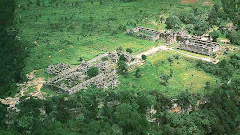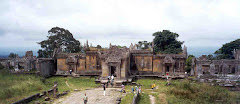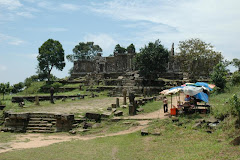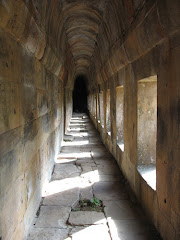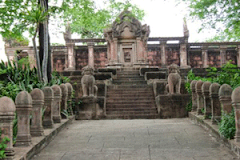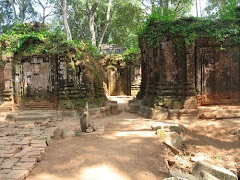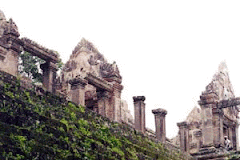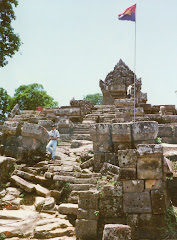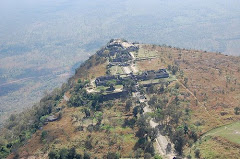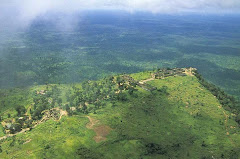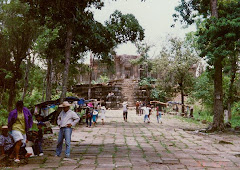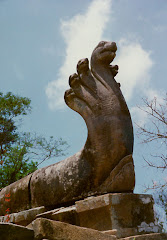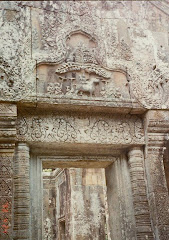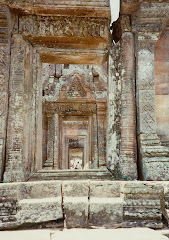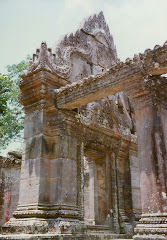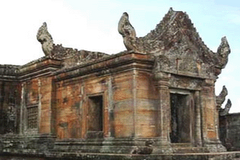
Indroduction
Preah Vihear is quite a big northern province of Cambodia. Its capital is called Phnom Tbeng Meanchey. The province itself is named after the temple of Prasat Preah Vihear, what is definitely the hotspot of this province. Much of the province is extremely remote and strongly forested. Unfortunately do large logging companies reduce the natural landscape by carving huge tracts of pristine tropical hardwoods out of the locations. It is also one of the least populated provinces in the Kingdom of Cambodia. This tranquil site is popular for the Preah Vihear temple, standing in the vicinity of the borderline between Thailand and Cambodia.
The province has one of the worst infrastructures in the country – there are even no proper Major Roads in existence. Going around this province is not that easy if you’re used to proper roads and usual transportation possibilities, as there are only a few pick-ups or some money-hunting moto drivers to take you where you would like to go.
The province has one of the worst infrastructures in the country – there are even no proper Major Roads in existence. Going around this province is not that easy if you’re used to proper roads and usual transportation possibilities, as there are only a few pick-ups or some money-hunting moto drivers to take you where you would like to go.
Whatsoever the province has a lot to offer for those, who are interested in ancient temple structures and remote villages without touristy influence. Here in Preah Vihear you may find three of the most impressive legacies from the Angkorian era: the mountain temple of Prasat Preah Vihear, the 10th-century capital of Koh Ker and the mighty Preak Khan. Koh Ker is nowadays easily accessible from Siem Reap via Beng Mealea, but the other two still remain difficult to visit, requiring long and tough overland journeys and a distinct possibility to spend a night in the jungle. During the wet season these places are more or less unreachable. But there are governmental plans to develop the region for a smooth but constant tourism, building roads and improving infrastructure.
The provincial capital Tbeng Meanchey is due to the state of the infrastructure and it’s geographical location not visited by a lot of foreigners. Most of them don’t make it here worrying about the street conditions and the backcountry feeling of no fast supply in need. The city is sprawling and dusty and consists of little more than two small major dirt roads form South to North. There is nothing interesting in town or to do, so it has necessarily become more a stopover on the way to Koh Ker and Preah Khan.
The provincial capital Tbeng Meanchey is due to the state of the infrastructure and it’s geographical location not visited by a lot of foreigners. Most of them don’t make it here worrying about the street conditions and the backcountry feeling of no fast supply in need. The city is sprawling and dusty and consists of little more than two small major dirt roads form South to North. There is nothing interesting in town or to do, so it has necessarily become more a stopover on the way to Koh Ker and Preah Khan.
Biography

Preah Vihear province is 13,788 square kilometres big. It’s located in the North of the country and shares its international border to the North with Thailand and Laos, its provincial borders to the East with Stueng Treng, to the West with Oddar Meanchey and Siem Reap and to the South with Kompong Thom. The province is blessed with endless natural treasure. With its acres of dense, hilly forests and scrub green vegetation, Preah Vihear is indeed an ideal getaway destination in the lap of nature. The breathtaking views over the Dangkrek Mountains and lush jungle from Preah Vihear temples are famous.
Population
The current population in this province is about 160,551 people or 1.1% of the country’s total population (14,363,519 person in Cambodia, 2007, provincial government data), with 81,318 male and 78,233 female. The population density is therefore 11.64 people per square kilometre.
Climate
The country has a tropical climate - warm and humid. In the monsoon season, abundant rain allows for the cultivation of a wide variety of crops. This year-round tropical climate makes Cambodia ideal for developing tourism. Travellers need not to fear natural disasters such as erupting volcanoes or earthquakes, and the country is not directly affected by tropical storms.
Climate: Cambodia can be visited throughout the year. However, those plans to travel extensively by road should be avoided the last two months of the rainy season when some countryside roads may be impassable. The average temperature is about 27 degrees Celsius; the minimum temperature is about 16 degrees. December and January are the coolest months, whereas the hottest is April.
General information about the provincial climate:
- Cool season: November- March (22-28c)
Climate: Cambodia can be visited throughout the year. However, those plans to travel extensively by road should be avoided the last two months of the rainy season when some countryside roads may be impassable. The average temperature is about 27 degrees Celsius; the minimum temperature is about 16 degrees. December and January are the coolest months, whereas the hottest is April.
General information about the provincial climate:
- Cool season: November- March (22-28c)
- Hot season: March- May (27c -35c) - Rainy season: May - October (24-32c, with humidity up to 90%.)
Economy
The province’s economy is 85% based on farming and the remaining other 15% are based on fishing and illegal trading with pristine hardwoods. Because of its border with Thailand, the international trade is also increasing slightly and becoming another important sector of the province’s economy. There is several developing plans from province based NGO’s, the Ministry of Foreign Affairs from Thailand and Cambodian government itself. The economy and infrastructure of the province was also sustainably destructed during the Khmer Rouge stand and needs therefore a whole new stabile backbone.
How To Get There
General Information (Share taxi/Pick-up/Motorbike): To get into this remote province you have two possibilities, one is a packed laterite Major Road from Siem Reap via Anlong Veng, with a distance of over 200 km (completed in 2003). The other access to Preah Vihear is from Kampong Thom via NH 64, which is about 155km South of Tbeng Meanchey. The last one is probably the easiest and fastest way to go to Tbeng Meanchey. Pick-ups go almost daily in the morning and noon to the provincial capital of Preah Vihear from Kampong Thom market ($2-4 depending if you’re inside or on the back). The comfortable share taxi is the other and faster option for $5-7. The road leading there is in horrendous condition as the logging freeze means no one has done any maintenance for a couple of years. The last 30km to Tbeng Meanchey climb some hills, which may get very nasty during the wet season with small creeks to minor rivers. You can also reach the place on a two to three days motorbike trip from Kompong Thom. Be aware of the road conditions and try to judge your personal experience on dusty, bumpy roads in the jungle. A new other road has been constructed linking Siem Reap to Koh Ker (attraction side). From there, it's an ardous day ride on badly worn out dirt and sand tracks to Preah Vihear (famous temples).
Motorbike Info (Khampong Thom – Preah Vihear): Kompong Thom is the starting point for a real adventurous tour to the seldom-visited jungle plains of northern Cambodia. This 2-3 days motorbike ride to Preah Vihear is offered by some of the moto-taxi drivers, who will propose it to you once they spot you getting off the bus ($30-50). With you sitting on the back of the bike, your driver will take you through peaceful villages and rice paddies, passing by friendly locals, spending a night with a local family and visiting the temples of Preah Khan Kompong Thom and Koh Ker on your way up. A part of the journey leads you along an old Angkorian road and over its ancient bridges. The ride itself is hardship, skidding over sticks and stones, through sand oceans and bamboo forests, sometimes fording small rivers. From Preah Vihear, you will head to Siem Reap via Anlong Veng, the place where Pol Pot is said to have died. It’s a worth a ride, but put your motorbike skills on question before you go for it.
Motorbike Info (Khampong Thom – Preah Vihear): Kompong Thom is the starting point for a real adventurous tour to the seldom-visited jungle plains of northern Cambodia. This 2-3 days motorbike ride to Preah Vihear is offered by some of the moto-taxi drivers, who will propose it to you once they spot you getting off the bus ($30-50). With you sitting on the back of the bike, your driver will take you through peaceful villages and rice paddies, passing by friendly locals, spending a night with a local family and visiting the temples of Preah Khan Kompong Thom and Koh Ker on your way up. A part of the journey leads you along an old Angkorian road and over its ancient bridges. The ride itself is hardship, skidding over sticks and stones, through sand oceans and bamboo forests, sometimes fording small rivers. From Preah Vihear, you will head to Siem Reap via Anlong Veng, the place where Pol Pot is said to have died. It’s a worth a ride, but put your motorbike skills on question before you go for it.
Where to Eat
General Information: With exception of the small market and a couple of food stalls on the street, there are only a couple of eateries in town. In front of the taxi station you may find a couple of small restaurants offering noodle and rice dishes and fresh coffee.
Dara Reas Restaurant: This place is located 200m west from the roundabout and 1km south from the market. It is a larger garden restaurant that’s popular with well-to-do locals. It offers good grub concerning the so –to-say end of the world and some nice pavilion for small groups. Typical Khmer food.
Mlop Dong Restaurant: This restaurant comes with reasonable food, and the range of dishes is also heartening for this part of the world. It is quite a popular place for expats living in town, and after dinner this is about the closest thing to a pub this town boasts.
Dara Reas Restaurant: This place is located 200m west from the roundabout and 1km south from the market. It is a larger garden restaurant that’s popular with well-to-do locals. It offers good grub concerning the so –to-say end of the world and some nice pavilion for small groups. Typical Khmer food.
Mlop Dong Restaurant: This restaurant comes with reasonable food, and the range of dishes is also heartening for this part of the world. It is quite a popular place for expats living in town, and after dinner this is about the closest thing to a pub this town boasts.
Where To Stay
Mlop Trosek Guesthouse: (tel: 012/952035) A favourite place in this small town, with a large, green garden and clean rooms with attached bathroom and plenty of secure parking if you come with a motorbike. The newly refurnished rooms are lighter and brighter than those near the front and also have genuine lino floors. Prices are around US$4-5.
Prom Tep Guesthouse: (tel: 012/ 964645) Located north from the market than the first block turning east, this is the closest thing to a hotel in this part of Preah Vihear. The rooms are really spacious and comfortable with standard satellite TV, attached Western bathroom and air-con. The prices range from US$6-12.
27 May Guesthouse: (tel: 011/905472) This place is near the market situated. One of the very budget accommodations in town, with quite clean rooms including a bath and some of the rooms come with air-con. There are also very small rooms for $1.5 with share bathroom. The only pity is, that it is near the market, so it could get a little noisy in the morning. The rooms come for US$1.5-5.
Phnom Meas: (tel: 012/632017) This small guesthouse is located east of the taxi station. It features small rooms with bath and TV and bigger rooms with no windows. The price is around $4-8.
Prom Tep Guesthouse: (tel: 012/ 964645) Located north from the market than the first block turning east, this is the closest thing to a hotel in this part of Preah Vihear. The rooms are really spacious and comfortable with standard satellite TV, attached Western bathroom and air-con. The prices range from US$6-12.
27 May Guesthouse: (tel: 011/905472) This place is near the market situated. One of the very budget accommodations in town, with quite clean rooms including a bath and some of the rooms come with air-con. There are also very small rooms for $1.5 with share bathroom. The only pity is, that it is near the market, so it could get a little noisy in the morning. The rooms come for US$1.5-5.
Phnom Meas: (tel: 012/632017) This small guesthouse is located east of the taxi station. It features small rooms with bath and TV and bigger rooms with no windows. The price is around $4-8.
Shopping
As it is quite common in Cambodia even small cities, such as Tbeng Meanchey have at least one market. You may also find a small market in Tbeng Meanchey centre, which is a busy area with local shops dealing the local daily consumer products, like fish, fruits, vegetables, meats and packed products (a lot from Thailand). Most of the food and drink shops are surrounding the market.
Points of interest of Preah Vihear Province Include:-Preah Vihear Temple - Koh Ker Temple- Neang Khmao Temple-Pram Temple-Chen Temple-Preng Well-Rampart of Koh Ker Temple-Kuk Temple or Gopura-Prang Temple-Krahom Temple-Khmao Temple-Bakan or Preah Kham Temples-Noreay Temple-Phnom Pralean Temple-Neak Buos Temple-Krapum Chhouk Temple-Kork Beng Temple-Foof of Phnom Tbeng Wat Bak Kam-Wat Peung Preah Kor
Preah Vihear Temple
 Preah Vihear temple is located in Svay Chhrum village, Kontuot commune, Choam Ksan district, about 108 kilometers north of Preah Vihear provincial town. Preah Vihear province was created in 1964 by cutting the land from Stung Treng, Kampong Thom and Riem Reap provinces. The province is at the north of Cambodia, on the plateau that is rich in forests, mountains and streams.
Preah Vihear temple is located in Svay Chhrum village, Kontuot commune, Choam Ksan district, about 108 kilometers north of Preah Vihear provincial town. Preah Vihear province was created in 1964 by cutting the land from Stung Treng, Kampong Thom and Riem Reap provinces. The province is at the north of Cambodia, on the plateau that is rich in forests, mountains and streams. 
The temple was originally known as Sreisikharesvara, which means the power of the mountain.

 The temple was built over 300 years in the late 9 th and early 12 th centuries to worship Shiva Brahmanism by four kings:
The temple was built over 300 years in the late 9 th and early 12 th centuries to worship Shiva Brahmanism by four kings:
King Yasovarnam I (A.D. 889-900 or 910?)
The king built the central tower of Preah Vihear temple. King Yasovarnam I built Yasodharapura city and preferred to build the temple on a natural mountaintop.
King Surayavarman I (A.D. 1002-1050)
The king built a long hall next to the central tower, the rampart and three Guparas (gateway). According to the temple inscription, the king prepared a ceremony to invite the god Patresvara who stay Wat Pu (now in Lao) to stay together with the god Sreisikharesvara to protect and take care of the Khmer Empire and its people.
King Jayavarman VI (A.D. 1080-1109)
The King built two libraries and repaired some parts of the temple.
King Suryavarman II (A.D. 1113-1150)
The king built a terrace with seven-head-nagas, statues of standing lions a long the working path and some more naga staircases. He also prepared the inauguration ceremony for the temple and regarded it as a worship place for all kings.

There are many Brahmanism stories sculpted on the fronton of Preah Vehear temple. Two of those stories are very meaningful. One is the story of victory of Krishna over Bana the Demon king. This story represents the victory to get fresh water from Yumnea river. Another story is about the Churning of the Ocean of Milk.

Preah Vihear temple, which is 800 meters long and 400 meters wide, sits atop the 625 meter-high Phnom Preah Vihear in the Dangrek Mountain range on the border of Thailand.
 The Cambodian side of the mountain is very steep, while the Thai side is gently rolling. There are three ways to reach Preah Vihear temple:
The Cambodian side of the mountain is very steep, while the Thai side is gently rolling. There are three ways to reach Preah Vihear temple:-From Cambodia by the ancient road Svay Chhrum. There is staircase to the mountaintop.
-From Cambodia by Kor 1 road, which has been reconstructed with concrete. Most local people and sellers go up the mountain by this road.
-From Thailand, the route most popular with foreign visitors. Foreigners can also get to the temple from the Cambodian side, today the route a little easy.
Preah Vihear temple is a cultural and historical site. The French handed over the temple to Thailand in 1954. It’s was returned to Cambodia on June 15, 1962, in a decision rendered by the International Court.

Under the Franco-Siamese Treaty of 1904 and 1907, the line of frontier between Cambodia and Thai along the Dongrak Mountains followed justice at the Hague officially found that the Preah Vihear Temple situated inside the Cambodia territory.
The World Heritage Committee, meeting for its 32nd session, finished inscribing the Temple of Preah Vihear sites on UNESCO’s World Heritage List on 8 July with the addition of 19 cultural sites and eight natural sites to the List.
General Detail

Gopuras on the third level: This group of building was the King’s residence when he came to pay homage to the mighty God, and the two wings were the shelters for the pilgrims. The main temple is used for the high-ranking supreme divinities, this mighty group of building is considered as the center of the whole temple complex.

-The front stone stairway: this main passage is on the North side. The stairway is 8 meters wide and 78 meters long,. The fist flight has 162 steps. At the first landing is a large stone singa statue on stone block. Another 54 flight of steps 4 meters wide and 27 meters long leads up to the second landing also decorated with stone signa statue.

-The Nagaraj Courtyard : this stone-paved is 7 meters wide by 31.8 meters long. From here the stairway leads up to the first-level Gropura. The Stairheads are in the form of seven-headed snakes called "Ngu Suang " facing North towards the Prasat. The heads and tails of nagas on both sides look like ordinary snakes, characterizing and early example of this type of animal figures. The head portion of the naga on the west side looks very impressive because it is made from a single solid stone.

-The first level Gopura : this is a pavilion in Greek architecture style with cross plan on an elevated, rebates angle base on each of the roof doorway . Stone lions are placed on each of the roofs doorway.
The temple can be reached by crossing the Cambodia-Thai gateway border from the Ubon Ratchantani Province of Thailand. Currently the visits are from 8.00 till 16.00 hours.
For all the grandeur of its site, perched on the edge of a giant cliff and with a commanding view over northern Cambodia, Preah Vihear is difficult to visualize as a whole. The experience is truly a memorable one – the series of ascents over the best part of a kilometer, the ornate Gopuras and the wealth of decorative detail truly staggers one’s imagination.

-The front stone stairway: this main passage is on the North side. The stairway is 8 meters wide and 78 meters long,. The fist flight has 162 steps. At the first landing is a large stone singa statue on stone block. Another 54 flight of steps 4 meters wide and 27 meters long leads up to the second landing also decorated with stone signa statue.

-The Nagaraj Courtyard : this stone-paved is 7 meters wide by 31.8 meters long. From here the stairway leads up to the first-level Gropura. The Stairheads are in the form of seven-headed snakes called "Ngu Suang " facing North towards the Prasat. The heads and tails of nagas on both sides look like ordinary snakes, characterizing and early example of this type of animal figures. The head portion of the naga on the west side looks very impressive because it is made from a single solid stone.

-The first level Gopura : this is a pavilion in Greek architecture style with cross plan on an elevated, rebates angle base on each of the roof doorway . Stone lions are placed on each of the roofs doorway.
The temple can be reached by crossing the Cambodia-Thai gateway border from the Ubon Ratchantani Province of Thailand. Currently the visits are from 8.00 till 16.00 hours.
For all the grandeur of its site, perched on the edge of a giant cliff and with a commanding view over northern Cambodia, Preah Vihear is difficult to visualize as a whole. The experience is truly a memorable one – the series of ascents over the best part of a kilometer, the ornate Gopuras and the wealth of decorative detail truly staggers one’s imagination.
Koh Ker Temple
Koh Ker was once an ancient capital of Cambodia, located in Srayong Cheung village, Srayong commune, Kulen district, about 49 kilometers west of the provincial town. The Koh Ker complex is on the Chhork Koki highland. It was built by King Jayavaraman IV (AD 928-942). Koh Ker temple is 35 meters high, and its design resembles a seven-stepped stupa. The temple faces west toward Angkor city. It was built to worship Treypuvanesvara, the god of happiness.
About 300 meters farther to the west is Kampiang or Koh Ker temple. From a distance, the temple looks like a small hill, because it is covered by forest. Up close, however, it is actually a 35-meter-high stupa made of sandstone. It has seven levels, each level about 5 meters above the other. Each deck has a 2-meter-wide terrace, and there is a 55- step staircase to the top. At the top of the temple, there are large statues of garudas supporting Shiva lingam Treypuvanesvara. Nearby, there is a 4-meter square well, now completely covered by grass. According to local villagers, if a coconut is dropped into this well, it will appear in the pond near Neang Khmao temple. There is vegetation growing on top of the temple, and from there visitors have an excellent view of the surrounding landscape, in particular, Phnom Dangrek, Phnom Tbeng, and Kulen district.
To the north of Koh Ker temple is another temple, Damrei Sar temple, but it is heavily damaged. To the northeast, is Iingam temple. This temple once housed three Shiva lingams, but some are now damaged.
So far, 96 temples have been found in Koh Ker: Dav, Rumlum Bey, Beung Veng, Trapiang Prey, Dey Chhnang, Srok Srolao, Lingam, Kuk Srakum, Trapiang Ta, Sophy, Krahom, Andoung, Ang Khna, Teuk Krahom, Damrei Sar, Krarab, Banteay Pichoan, Kuk, Kmao, Thneung, Thorn Balang, Rohal, Chamneh, Sampich, Trapiang Svay, Neang Kmao, Pram, Bat, Khnar Chen, Klum, Chrab, Dangtung, Prang, Kampiang.... These temples were not constructed near each other. Today, many of them are no longer standing, and some are buried in the ground. The followings are locations and descriptions of some of the Koh Ker temples:
About 300 meters farther to the west is Kampiang or Koh Ker temple. From a distance, the temple looks like a small hill, because it is covered by forest. Up close, however, it is actually a 35-meter-high stupa made of sandstone. It has seven levels, each level about 5 meters above the other. Each deck has a 2-meter-wide terrace, and there is a 55- step staircase to the top. At the top of the temple, there are large statues of garudas supporting Shiva lingam Treypuvanesvara. Nearby, there is a 4-meter square well, now completely covered by grass. According to local villagers, if a coconut is dropped into this well, it will appear in the pond near Neang Khmao temple. There is vegetation growing on top of the temple, and from there visitors have an excellent view of the surrounding landscape, in particular, Phnom Dangrek, Phnom Tbeng, and Kulen district.
To the north of Koh Ker temple is another temple, Damrei Sar temple, but it is heavily damaged. To the northeast, is Iingam temple. This temple once housed three Shiva lingams, but some are now damaged.
So far, 96 temples have been found in Koh Ker: Dav, Rumlum Bey, Beung Veng, Trapiang Prey, Dey Chhnang, Srok Srolao, Lingam, Kuk Srakum, Trapiang Ta, Sophy, Krahom, Andoung, Ang Khna, Teuk Krahom, Damrei Sar, Krarab, Banteay Pichoan, Kuk, Kmao, Thneung, Thorn Balang, Rohal, Chamneh, Sampich, Trapiang Svay, Neang Kmao, Pram, Bat, Khnar Chen, Klum, Chrab, Dangtung, Prang, Kampiang.... These temples were not constructed near each other. Today, many of them are no longer standing, and some are buried in the ground. The followings are locations and descriptions of some of the Koh Ker temples:
Neang Khmao Temple
The Koh Ker complex is along a trail that is about 3 kilometers long. The first temple, Neang Khmao sits atop a small hill on the east side of the trail. The temple, which faces west toward Angkor city, is made of sandstone. It is 20 meters high and resembles a stupa. The temple terrace is 2 meters high and divided into three decks. The temple is surrounded by a laterite rampart, 44 meters square and 2 meters high. The rampart has only two openings; one on the east side, and the other on the west. The temple once housed lingam and yoni, but only yoni remains. The lintel sculpture has been damaged, but otherwise, most of the temple is in good condition, while nearly three-quarters of the rampart is good condition.
Pram Temple
About 700 to 800 meters north of Neang Khmao temple is another temple called Pram temple. Constructed of laterite and sandstone, it sits on a small hill surrounded by bushes that block the lingam and the lintel. The main body of the temple is in good condition.
Chen Temple
Farther down the trail is a three-peak temple made of laterite and sandstone. It faces east and is called Chen temple. Inside the temple there is a piece of lingam and remnants of a statue of King Jayavarman IV. A sculpture of garuda's head on the south lintel is missing. The temple is overgrown by forest.
Preng Well
About 800 to 900 meters farther, there is the Preng well, which is similar to a pond. Surrounded by stone, it is 20 meters square. The terrace is about 8 centimeters high. The water in the pond is clear, and a nearby tree provides shade for weary visitors looking for a place to relax.
Rampart of Koh Ker Temple
Another kilometer down the trail is the rampart of Koh Ker temple. 1 kilometer long and 2 kilometers high, it is made of laterite. Koh Ker temple is the middle of a rampart, surrounded by 20 more temples. Some of the temples are:
Kuk Temple or Gopura
Kuk temple or Gopura is made of sandstone and has a sculpture of lotus petals on the temple fronton. Although the door frame is damaged, most of the temple is in good condition. A Shiva lingam that once was housed inside has been looted.
Prang Temple
Prang temple is constructed of sandstone and bricks. There are five separate parts of this temple. About 70 percent of the temple is still standing.
Krahom Temple
About 10 meters farther is Kramhom temple (The red temple). Constructed of brick and shaped like a seven-level pyramid, the temple is decorated with a 20-meter-tall sculpture of lotus petals. Inside the temple, there is a 3-meter-tall statue of Shiva with eight arms and four heads. The statue is supported by a l-square-meter base. The statue is seriously damaged, only some parts remain.
Khmao Temple
Farther down is Khmao temple. On the wall and door frame of the temple, there is a partially damaged inscription. Near the temple is a rampart gateway to Kampiang temple. The gateway is a 2-meter staircase. Some sculptures of lotus petals, seven-headed nagas and garudas remain.
Bakan or Preah Kham Temples
The Bakan temples are located in Ta Siang village, Ronakse commune, Sangkum Thmei district, about 105 kilometers southwest of the provincial town. The temple was built in the reign of King Suryavarman I (AD 1002-1050), on a plain that was a former worship place of the king. The temple is surrounded by two ramparts-inside and outside rampart. Inside each rampart, there are many other temples such as Neang Peou and Dangkao Baodos temples.
The temple was likely a royal palace and worship place. According to historians, the site used to be a hiding place of King Jayavarman VII before he ascended to the throne in AD 1181 because the style of some construction is similar to the style of Bayon and Ta Prohm temples.
Outside the rampart, there are many other temples such as Preah Damrei, Preah Thkaol, Ta Prohm, Muk Buon and Preah Stung temples.
The temple was likely a royal palace and worship place. According to historians, the site used to be a hiding place of King Jayavarman VII before he ascended to the throne in AD 1181 because the style of some construction is similar to the style of Bayon and Ta Prohm temples.
Outside the rampart, there are many other temples such as Preah Damrei, Preah Thkaol, Ta Prohm, Muk Buon and Preah Stung temples.
Noreay Temple
Noreay temple are located in Krala Peal Village, Pring Thom commune, Choam Ksan district, about 32 kilometers northeast of Preah Vihear provincial town. There are 3 temples stand separate from each other about 200 meters. The first site is surrounded by double rampart which is 100 meters long and 50 meters wide made of laterite. It includes five temples made of sandstone, laterite and brick. The second site was completely damaged only temple base remain. The third site house Preah Noreay, but the temple was seriously damaged only Preah Noreay statue remain.
According to the study, Noreay temple was built at the same time with Sambo Preykuk temple in 7th century. The temples are recently completely covered by forest.
According to the study, Noreay temple was built at the same time with Sambo Preykuk temple in 7th century. The temples are recently completely covered by forest.
Phnom Pralean Temple
Phnom Pralean temple is on a 180 meters small hill located in Krang Dong village, Preah Kliang commune, Tbiang Meanchey district, about 25 kilometers from the provincial town. The laterite and sandstone temple, built to worship Brahmanism, is 160 meters long and 60 meters wide. Surrounding the temple is a beautiful nature and abundant fresh airs where a good place to visit is.
Neak Buos Temple
Neak Buos Temple is located in Choam Ksan district, about 75 kilometers north of Tbiang Meancheay provincial town. The laterite, sanstone and brick temple is 50 meters square and built on a plain to worship Brahmanism. It is very difficult to reach the temple because of bad road condition.
Krapum Chhouk Temple
Krapum Chhouk is located Romdos commune, Rovieng district, about 45 kilometers south of the provincial town. The laterite and sandstone temple was built in the late 10th century to worship Brahmanism.
Kork Beng Temple
Kork Beng Temple is located in Wat Prasat Chey Preuk on Kork Beng Village, Kampong Pranak commune, Tbiang Meanchey district. The leterite amd sandstone temple was built between AD 936 and 951 by a commander name Kork on ordered from King Jayavarman IV. There is a hug Beng Tree near the temple. Therefore, the king named the temple Kork Beng. Today only a few stones of the ancient temple remain. The temple, however, was reconstructed with concrete in 1988. The new temple is 8 meters high and 12 meters square. There is a statue of Bodhisattva in temple center, where the worship place is.
Foof of Phnom Tbeng Wat Bak Kam
Wat Bak Kam is located along Tbeng mountain foot in Bak Kam village, Chhien Muk commune, Tbeng Meanchey district, about 17 kilometers west of the provincial town. The pagoda is 1, 000 meters long and 400 meters wide. The site offers nice view, forest and fresh air year round. Local villagers usually visit this site during holidays or national festivals.
Beside the pagoda, there is a large rock called Thma Peung Angkam (Thma Peung means overhanging rock and Angkam mean chaff). According to the local people, in the past, because of the failure of war with neighboring country, the Khmer commander and his troops hide under that rock. They cultivated rice in a nearby field to support their living. They husked rice under that rock and left the chaff. Later, local villagers found a lot of chafff under the rock, which is why the place is call Thma Peung Angkam. The rock is alos believed to be an important worship site.
Beside the pagoda, there is a large rock called Thma Peung Angkam (Thma Peung means overhanging rock and Angkam mean chaff). According to the local people, in the past, because of the failure of war with neighboring country, the Khmer commander and his troops hide under that rock. They cultivated rice in a nearby field to support their living. They husked rice under that rock and left the chaff. Later, local villagers found a lot of chafff under the rock, which is why the place is call Thma Peung Angkam. The rock is alos believed to be an important worship site.
Wat Peung Preah Kor
Wat Peung Preah Kor is worship place located in Mohapol Village, Chhean Muk commune, Tbeng Meanchey district, next to the foot of Tbeng mountain. The site features beautiful natures and is a good place for local and foreign visitors to relax. Superstitious people believe that the site is very powerful.
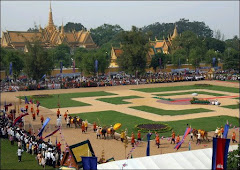

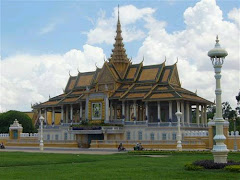

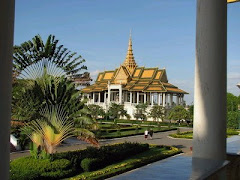
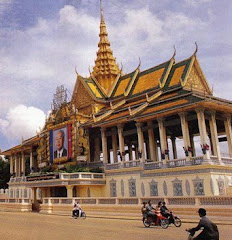
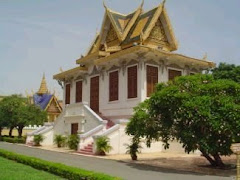
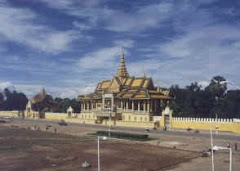
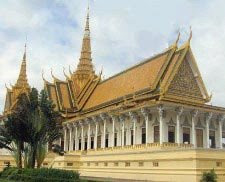

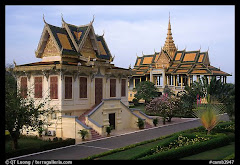





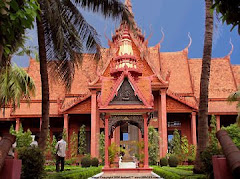
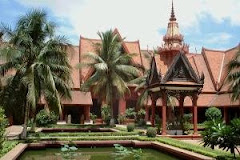




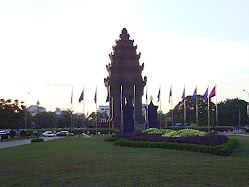



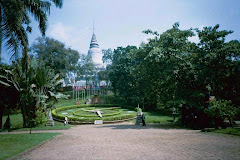

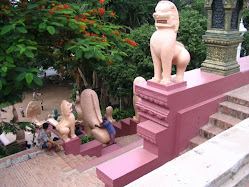
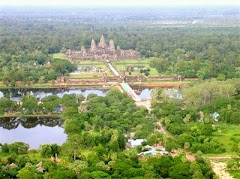
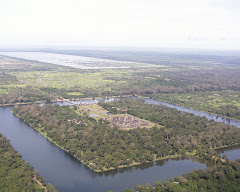

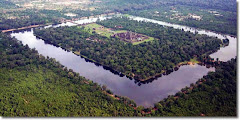
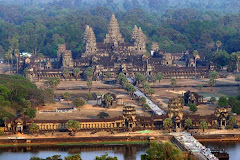
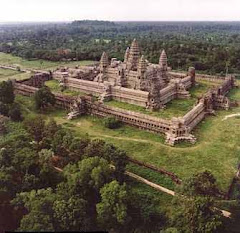
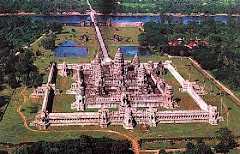
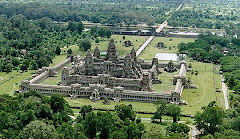
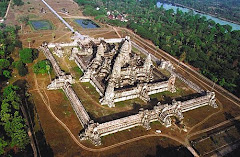

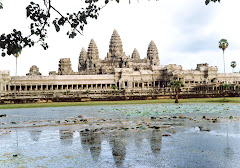

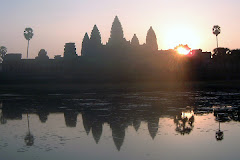
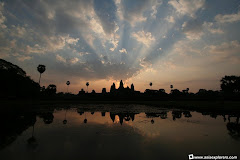
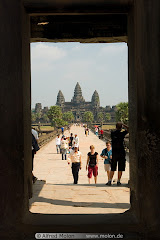
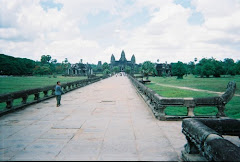
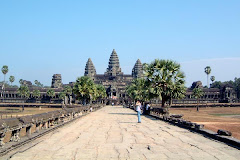
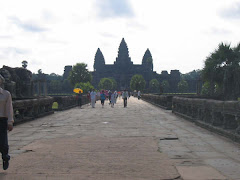
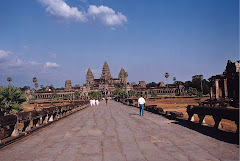
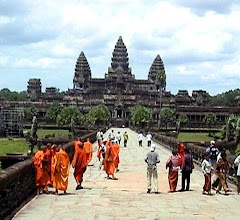
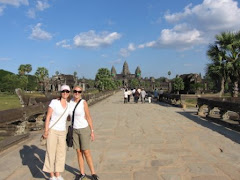
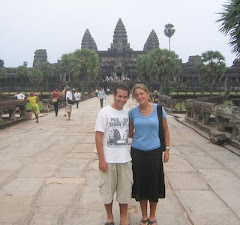
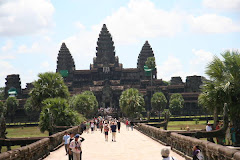
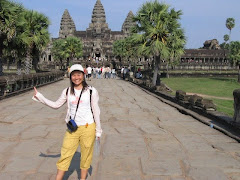
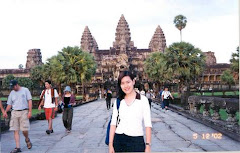

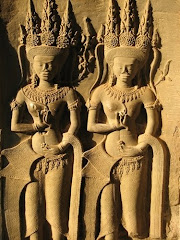

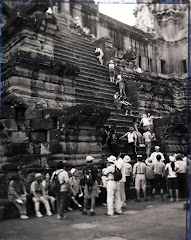

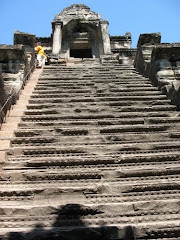

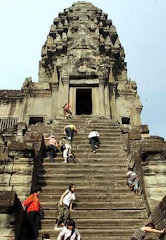
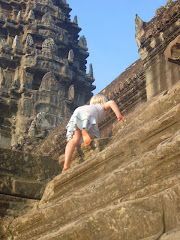
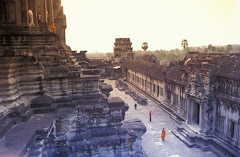
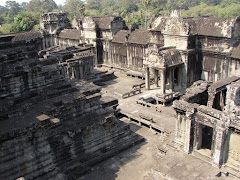
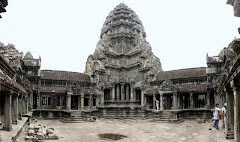
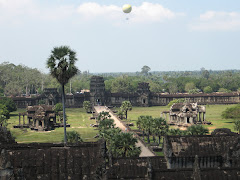


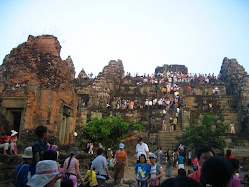

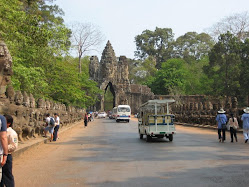

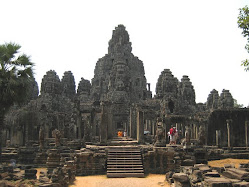
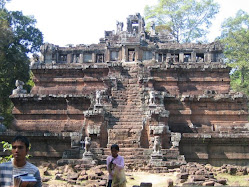.jpg)

